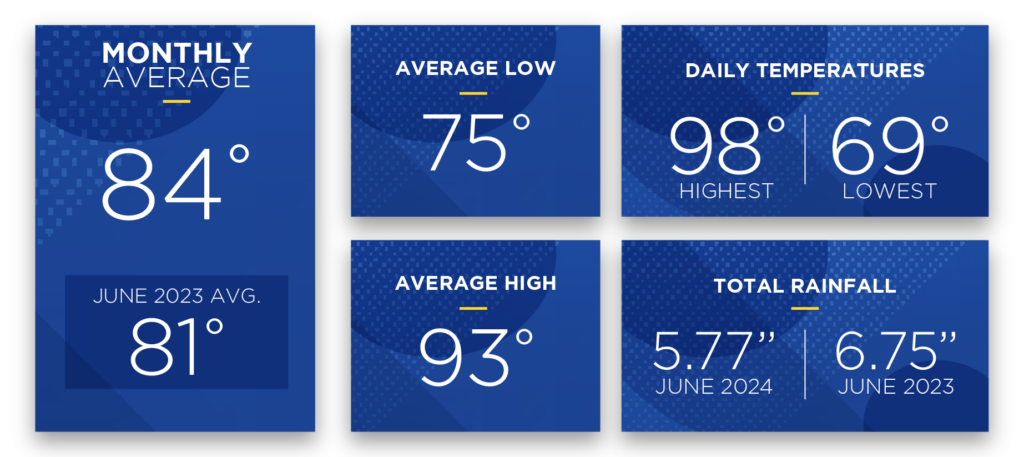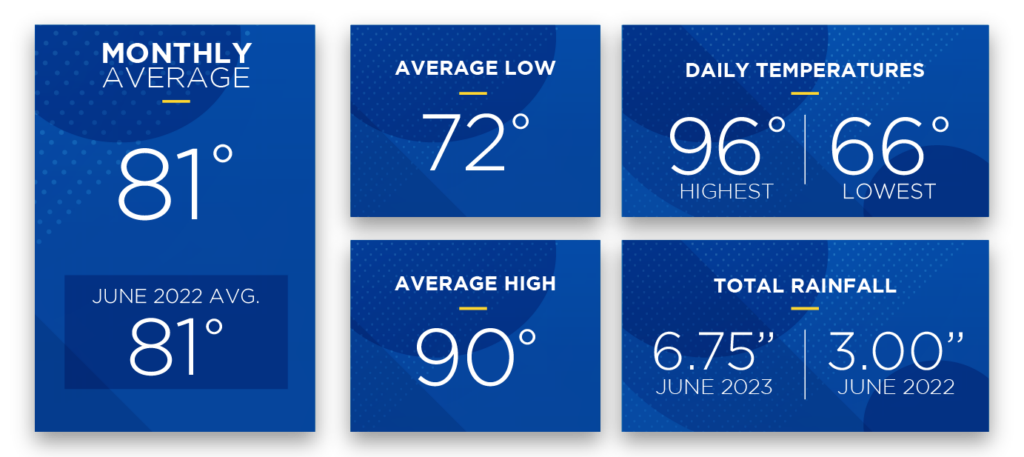June 2024 Sunshine State Stats
In June 2024, the average high and low temperatures climbed higher from last month, along with increased rainfall and thunderstorm activity across Central Florida. The month’s average high temperature was 93 degrees, 2 degrees higher than in May. The average low was 75, an increase of 4 degrees. The high and low June average temperatures were 2 degrees higher than the “normal” averages as recorded at Leesburg International Airport (KLEE). The month’s highest temperature of 98 degrees occurred on June 6, 8, and 9; the lowest temperature was recorded on June 2, touching 69 degrees.

Reported rainfall in June totaled 5.77 inches, .83 inches higher than in May, but still .36 inches lower than the “normal” amount for June. Measurable rainfall occurred on 13 of 30 days and did not begin until June 11. The rainiest day was June 28, when 2.48 inches fell.
WeatherSentry detected 6,777 cloud-to-ground lightning strikes within a 20-mile radius of Leesburg International Airport in June. The most active period was the last 14 days of the month when lightning struck 5535 times versus 1242 times during the first 16 days.
Lightning Archive Report – 20-mile radius from Leesburg International Airport (KLEE)
Data and charts provided by weathersentry.dtn.com

Cloud to Ground Lightning – June 1-16, 2024 (1242 strikes)

Cloud to Ground Lightning – June 17-30, 2024 (5535 strikes)
Florida residents know that thunderstorm activity is expected to be a mainstay of Central Florida’s summer weather, and SECO Energy reminds members to take shelter quickly if a thunderstorm approaches. Stay connected to SECO’s StormCenter for updates on outages and restoration progress. SECO offers a meter-based surge arrester designed to protect large appliances (motors and compressors) by reducing surges at the meter BEFORE they enter the home. Members can lease or purchase the Surge MitiGator surge protection program by completing a contact form.
Hurricane Season is now in its second month. It is important to prepare in advance for a storm’s arrival. Please refer to the SECO Energy Hurricane Handbook online here, or pick up a printed copy at one of our Member Service Centers.
July forecast from The Old Farmer’s Almanac:
The Old Farmer’s Almanac weather forecast for July 2024 is isolated thunderstorms and hot temps in the first 12 days, followed by five days of warm temps and continued storm activity. A three-day break of sunny and warm conditions is projected for June 19-21, and July is expected to conclude with more scattered thunderstorms and hot conditions during the final ten days.
The estimated average temperature for July is 85 degrees, and the expected rainfall is 6 inches, 1 inch less than the July average.
Online Energy-Efficiency Tools
Log into SmartHub to view past bills and consumption charts to check historical usage. If you want help in reducing your energy usage, SECO offers several energy-efficiency tools to help you identify energy wasters. Take the Home Energy Assessment to receive a detailed email tailored to your home’s features and lifestyle. The energy-saving advice will provide low-cost ways to decrease your usage – and your electric bill.
To easily calculate how much energy your appliances, lighting, electronic devices, and other energy-using items in your home consume, use the Energy Estimator.







